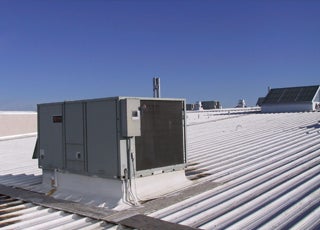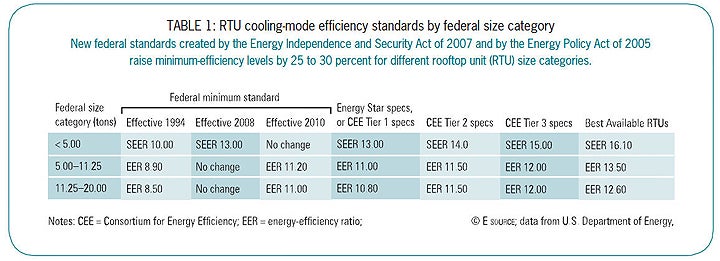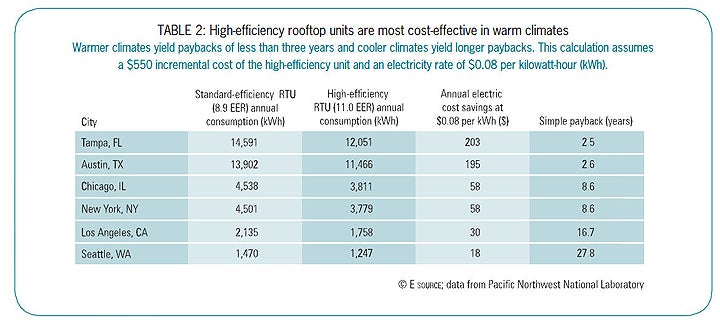DSO Electric Cooperative Inc. | 201 Dakota Drive | Solomon, KS 67480 | PO Box 286 | 1-800-376-3533
High-Efficiency Rooftop Units
High-efficiency rooftop units (RTUs) offer quick payback, lower energy costs, improved comfort, and reduced risk of equipment failure—making them a smart upgrade for commercial buildings.

Self-contained, packaged air-conditioning rooftop units cool about half of all U.S. commercial floor space. High-efficiency units are available now that can provide significant energy savings, improve occupant comfort, and reduce energy costs further by lowering peak demand. Some high-efficiency units can also meet the upcoming federal minimum-efficiency standards.
High-efficiency rooftop units (RTUs) can yield quick, simple payback periods that are often within two years. Replacing an older unit with a high-efficiency model can save money through reduced summer peak demand charges and year-round cooling costs. Replacing aging equipment can also reduce the risk of failure.

When the weather is warm, it takes a lot of energy to keep commercial buildings cool. In fact, cooling can account for over 20 percent of an office building's total electricity consumption. Self-contained, packaged RTUs are playing a more prominent role in cooling commercial buildings as RTU shipments for commercial applications have steadily increased since 1997.
As the number of shipments of RTUs has grown, so have their efficiency levels. For example, the number of models that met the Consortium for Energy Efficiency (CEE) 1993 Tier 1 minimum-efficiency recommendations grew from only 14 percent of available models in 1993 to at least 43 percent of available models in 2001. The CEE, a nonprofit organization that promotes the adoption of energy-efficient technologies, defined the 1993 Tier 1 minimum-efficiency recommendation as having an energy-efficiency ratio (EER) of at least 10.3, 9.7, and 9.5, respectively, for the small, large, and very large RTU size categories.
Today, many high-efficiency RTUs exceed these Tier 1 minimum efficiencies. Commercialized units in the small size range (65,000 to 135,000 Btu per hour) have EERs as high as 13.5, and units in the large size range (135,000 to 240,000 Btu/hour) now have EERs as high as 12.6. The most efficient unit in the under-5-ton size range (less than 65,000 Btu/hour) has an EER of 14.3 and was released in January 2008.
Newer RTUs also have factory-installed microprocessor controls that reduce the energy consumption of the overall system while maintaining comfortable conditions in the building. The most common control strategies are scheduling and lockouts. Scheduling turns the unit on or off depending on the time of day, day of the week, or other variables such as outside air conditions. Lockouts can be used to override the schedule and keep a unit off, for example, for a unit that conditions an unoccupied part of a building. Most new units also have an optional communication interface for connection to an energy-management system or a demand-controlled ventilation system.
Manufacturers are also starting to apply variable air volume (VAV) capabilities to newer RTUs. VAV systems are able to condition spaces with different cooling and heating loads by matching the airflows to the different loads in different spaces. The technology employs variable-speed drives to supply the varied airflows. VAV not only improves occupant comfort, it also decreases energy use over single-zone systems because it reduces fan-energy consumption.
RTUs in the small, large, and very large size categories must meet the federal minimum-efficiency standards established in 1992. However, as the technology has improved, these standards are getting tougher. The Energy Policy Act of 2005 will introduce new standards for these RTU size categories on January 1, 2010, and will raise minimum-efficiency levels by 25 to 30 percent. The Energy Independence and Security Act of 2007 created new federal standards for RTUs in the under-5-ton size category and went into effect on June 16, 2008 (Table 1).
Efficiency metrics for RTUs are defined by the Air-Conditioning and Refrigeration Institute (ARI), a trade association representing air-conditioner manufacturers:
- EER, defined as the rate of cooling in Btu/hour divided by the power input in watts at full-load conditions, is a measure of full-load efficiency. The power input includes all inputs to compressors, fan motors, and controls.
- Integrated part-load value (IPLV) is a seasonal efficiency rating based on representative annual commercial loads, which means that the IPLV measures the efficiency of air conditioners at different loads. It applies to RTUs with cooling capacities equal to or greater than 65,000 Btu/hour.
- Seasonal energy-efficiency ratio (SEER) describes the seasonally adjusted rating based on representative residential loads, unlike EER, which describes the efficiency at a single rating point. SEER applies only to RTUs with a cooling capacity of less than 65,000 Btu/hour (5.4 tons). Although units less than 5 tons that use three-phase power are classified as commercial, they still use the residential SEER metric. This is because these small units are similar to the single-phase units used in residential applications, which have a large part of the market share in this size range. Older units of less than 5 tons often have SEERs as low as 6.
Both Energy Star and the CEE have also established efficiency specifications for high-efficiency RTUs, which are approximately 25 percent greater than the 1992 federal standards, but these specifications will likely be ratcheted up after the federal minimum standards are increased. The CEE suggests three tiers of efficiency levels for commercial equipment in the CEE Unitary Air/Conditioning Specification. Efficiency levels in Tier 1 are about 25 percent greater than those in the 1992 federal standard and closely match the levels specified in the new federal standard scheduled to take effect in 2010. Efficiency levels in Tiers 2 and 3 are even higher. The Energy Star specifications are roughly equivalent to the CEE Tier 1 efficiency specifications. Equipment that meets these specifications is awarded the Energy Star label, which helps consumers and others readily identify high-efficiency products.
A number of utilities offer incentives for commercial customers who purchase energy-efficient RTUs. These rebates are often based on the CEE's Tier 2 standards. Rebate programs typically pay customers around $30 per ton for high-efficiency units larger than 65,000 Btu per hour. Table 1 shows the federal, CEE, and Energy Star efficiency standards.

High-efficiency RTUs can provide the ability to reduce energy costs by reducing energy consumption and peak demand. An RTU with a high EER, or increased fullload efficiency, can reduce energy costs in the summer months when the cooling demand is high. RTUs with high IPLVs, or increased part-load efficiency, can reduce energy costs during the shoulder or swing months when cooling demand is lower and more variable.
As Table 2 shows, replacing existing RTUs, especially those near the end of the typical 15-year life expectancy, with high-efficiency units can save money. Not only are older units inherently less efficient, but their efficiency generally decreases as they age. In addition to causing an overall drop in energy consumption, replacing aging equipment will also remove the risk of mechanical failure and reduce summer peak demand charges.
RTUs are used extensively in small one- and two-story commercial and institutional buildings such as schools, restaurants, motels, retail stores, and small office buildings. Among these buildings, the largest savings from the use of high-efficiency units will come in buildings that have high cooling loads - such as those that have high occupancies or are located in hot climates. In those cases, high-efficiency RTUs, which cost more than standard units, have the potential to provide significant reductions in lifetime energy costs and can yield quick, simple payback periods that are often less than two years (Table 2).

High-efficiency RTUs have relatively high incremental costs but can pay for themselves fairly quickly through reductions in energy consumption and peak demand. Costs can vary significantly by manufacturer, region, dealer, and time of year - so, when evaluating RTU options, it's important to get local or regional price quotes. Data we gathered from one manufacturer show an initial capital cost of about $620 per ton for a 7- to 10-ton unit with an EER of 11.0.
Replacing aging RTUs early can save money. The cost-effectiveness of a high-efficiency RTU depends on several factors, including cooling loads, operating hours, and the local electricity rates. Table 2 shows simple payback calculations for purchasing a high-efficiency 7-ton unit with an EER of 11.0 over a standard 7-ton 8.9-EER unit in several U.S. cities. This calculation assumes a $550 incremental cost of the high-efficiency unit and an electricity rate of $0.08 per kilowatt-hour.
There are many resources to help you find, compare, and evaluate high-efficiency RTUs.
Air-Conditioning and Refrigeration Institute. ARI is the main source of information about energy-efficient RTU products. The ARI Online Directory (also available in print) includes products from all ARI member manufacturers. The organization maintains directories (available in both print and electronic formats) on its web site that include products from all ARI member manufacturers. The Consortium for Energy Efficiency maintains an easy-to-use directory of ARI-verified equipment that lists RTUs with capacities less than 65,000 Btu/hour using both three-phase (commercial) and single-phase (residential) power. The CEE also provides an Equipment Availability Table (40 KB Microsoft Excel format) showing the availability of models that meet each tier. Energy Star also establishes criteria for high-efficiency commercial air conditioners and provides a list of qualified units on the organization's Light Commercial Heat & Cooling web site.
Customer Direct Pamphlet
Licensed for distribution to the customers of E SOURCE members
